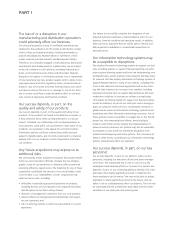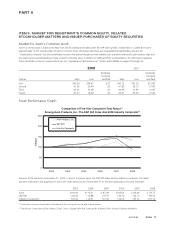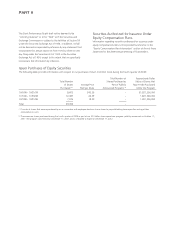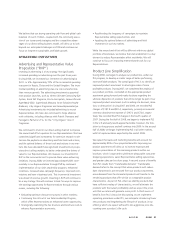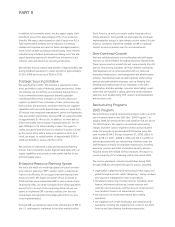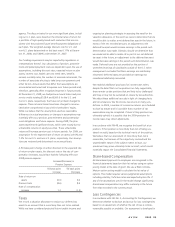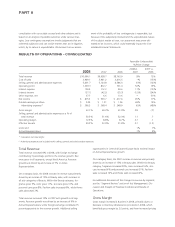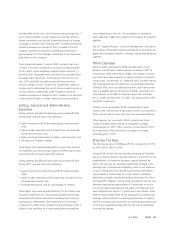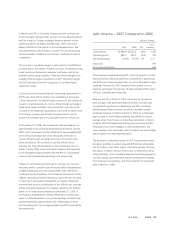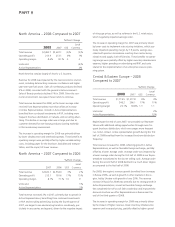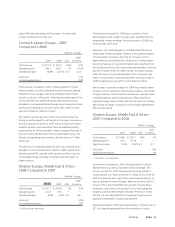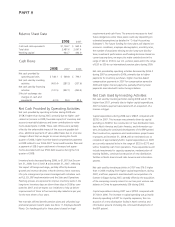Avon 2008 Annual Report Download - page 30
Download and view the complete annual report
Please find page 30 of the 2008 Avon annual report below. You can navigate through the pages in the report by either clicking on the pages listed below, or by using the keyword search tool below to find specific information within the annual report.PART II
the appropriate corporate authority, by accumulating detailed
estimates of costs for such plans. These expenses include the
estimated costs of employee severance and related benefits,
impairment of property, plant and equipment, contract termi-
nation payments for leases, and any other qualifying exit costs.
These estimated costs are grouped by specific projects within the
overall plan and are then monitored on a quarterly basis by
finance personnel. Such costs represent management’s best
estimate, but require assumptions about the programs that may
change over time, including attrition rates. Estimates are evalu-
ated periodically to determine if an adjustment is required.
Allowances for Doubtful Accounts
Receivable
Representatives contact their customers, selling primarily through
the use of brochures for each sales campaign. Sales campaigns
are generally for a two-week duration in the U.S. and a two- to
four-week duration outside the U.S. The Representative pur-
chases products directly from Avon and may or may not sell
them to an end user. In general, the Representative, an
independent contractor, remits a payment to Avon each sales
campaign, which relates to the prior campaign cycle. The Repre-
sentative is generally precluded from submitting an order for the
current sales campaign until the accounts receivable balance for
the prior campaign is paid; however, there are circumstances
where the Representative fails to make the required payment.
We record an estimate of an allowance for doubtful accounts on
receivable balances based on an analysis of historical data and
current circumstances. Over the past three years, annual bad
debt expense has been in the range of $145 to $195, or approx-
imately 1.7% of total revenue. We generally have no detailed
information concerning, or any communication with, any end
user of our products beyond the Representative. We have no
legal recourse against the end user for the collectability of any
accounts receivable balances due from the Representative to us.
If the financial condition of our Representatives were to deterio-
rate, resulting in an impairment of their ability to make pay-
ments, additional allowances may be required.
Allowances for Sales Returns
We record a provision for estimated sales returns based on histor-
ical experience with product returns. Over the past three years,
sales returns have been in the range of $295 to $370, or approx-
imately 3.4% of total revenue. If the historical data we use to
calculate these estimates does not approximate future returns,
due to changes in marketing or promotional strategies, or for
other reasons, additional allowances may be required.
Provisions for Inventory Obsolescence
We record an allowance for estimated obsolescence equal to the
difference between the cost of inventory and the estimated
market value. In determining the allowance for estimated obso-
lescence, we classify inventory into various categories based
upon its stage in the product life cycle, future marketing sales
plans and the disposition process. We assign a degree of
obsolescence risk to products based on this classification to
determine the level of obsolescence provision. If actual sales are
less favorable than those projected by management, additional
inventory allowances may need to be recorded for such addi-
tional obsolescence. Annual obsolescence expense was $80.8,
$280.6 and $179.7 for the years ended December 31, 2008,
2007 and 2006, respectively. 2007 and 2006 included incre-
mental inventory obsolescence charges of $167.3 and $72.6,
respectively, related to our PLS program and 2006 also includes
$20.5 related to our decision to discontinue the sale of heavily
discounted excess products. Obsolescence expense for 2008
benefited by approximately $13 from changes in estimates to
our disposition plan under our PLS program.
Pension, Postretirement and
Postemployment Benefit Expense
We maintain defined benefit pension plans, which cover sub-
stantially all employees in the U.S. and in certain international
locations. Additionally, we have unfunded supplemental pension
benefit plans for certain current and retired executives (see Note
11, Employee Benefit Plans).
For 2008, the weighted average assumed rate of return on all
pension plan assets, including the U.S. and non-U.S. plans was
7.66%. In determining the long-term rates of return, we con-
sider the nature of the plans’ investments, an expectation for the
plans’ investment strategies, historical rates of return and current
economic forecasts. We evaluate the expected long-term rate of
return annually and adjust as necessary.
The majority of our pension plan assets relate to the U.S. pension
plan. The assumed rate of return for 2008 for the U.S. plan was
8%, which was based on an asset allocation of approximately
35% in corporate and government bonds and mortgage-backed
securities (which are expected to earn approximately 4% to 6%
in the long term) and 65% in equity securities (which are ex-
pected to earn approximately 8% to 10% in the long term).
Historical rates of return on the assets of the U.S. plan for the
most recent 10-year and 20-year periods were 2.0% and 7.6%,
respectively. In the U.S. plan, our asset allocation policy has
favored U.S. equity securities, which have lost .7% and returned
8.4%, respectively, over the 10-year and 20-year periods. The
plan assets in the U.S. lost 26.2% and returned 9.3% in 2008
and 2007, respectively.
The discount rate used for determining future pension obliga-
tions for each individual plan is based on a review of long-term
bonds that receive a high-quality rating from a recognized rating


